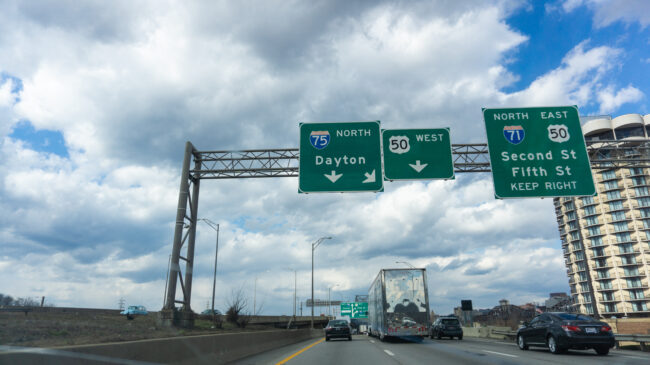When it comes to its impact on people and businesses, highway construction is getting short shrift from the Biden administration. While the Infrastructure Investment and Jobs Act (IIJA) increased formula highway funding, the Federal Highway Administration has tried to discourage state transportation departments from using their increased funding to add highway capacity, even where this would mean replacing a four-lane bottleneck bridge on a six-lane highway with a six-lane bridge. FHWA’s 2021 “guidance” memo on this was protested by many state transportation departments, as well as by governors and members of Congress.
The infrastructure bill also created a new discretionary program to help metro areas tear down urban freeways. And Congress also deserves blame for ignoring, in IIJA, the massive 2019 report from the Transportation Research Board that made the case for large-scale reconstruction and selective widening of the Interstate highway system. The report estimated this would require close to $1 trillion over a 20-year period. That neglect is especially short-sighted in light of a major new study on the economic value of the Interstate system.
Working Paper 27938 from the National Bureau of Economic Research estimates the annual economic value of the Interstate system as $742 billion. If the Transportation Research Board’s $1 trillion estimate of the cost of reconstruction is in the right ballpark, investing $1 trillion one time to preserve the annual value of $742 billion seems like a no-brainer.
Moreover, that $742 billion per year is only the economic value for goods movement due to faster and more reliable trips using the Interstate system. The economic value to individuals, families, and businesses from faster and safer long-distance travel via the Interstates is not included in that model. The study’s authors did not analyze those benefits, but if they are even one-third of those due to goods movement, the total annual benefits could approach $1 trillion per year. That makes the Interstate system’s one-time reconstruction cost of $1 trillion an incredible value proposition.
The study developed an ingenious methodology to estimate the goods-movement value-added. First, they built a very detailed model of freight flows among the 48 contiguous states, plus imports and exports via seaports and via land to and from Canada and Mexico. They modeled freight flows on this network down to the county level (over 3,000 counties across the country), taking into account traffic congestion levels to estimate trip times, and for each trip, they identified the best and second-best routes between origins and destinations.
After calibrating the model, they then removed the Interstate highways from the network and ran it again. The difference in annual economic value between the Interstate model and the one lacking Interstate highways was $742 billion in 2021 dollars.
The researchers also did additional model runs, each time removing only one Interstate corridor from the model to identify the value of individual Interstates with lots of truck traffic. From these model runs, they found that Interstate 75 had the highest annual value per mile—$29.3 million—for an annual value of $51.5 billion. The route with the highest annual value was I-80, at $66.7 billion.
These findings have critically important policy implications. First, they suggest that the traditional pay-as-you-go model, under which major highway projects are funded by annual appropriations of fuel tax money, is poorly suited to a national challenge such as rebuilding and modernizing the Interstates. The TRB report pointed out the benefits of long-term revenue-based financing of projects such as these. Yet federal law still does not permit tolls to be used to replace existing, worn-out lanes on Interstates; only lane additions and replacing obsolete bridges have clear-cut federal permission. Congress could fix this by liberalizing the existing three-state pilot program that allows toll-financed reconstruction of only a single Interstate corridor in each of the three states. Reason Foundation submitted legislative language to this end to the Senate Environment & Public Works Committee when it was debating what became IIJA, but it was not included.
The second implication of these findings is that the trucking industry’s long-standing opposition to tolling, spearheaded by its Alliance for Toll-Free Interstates, is misguided. The economic value of a rebuilt Interstate system so dwarfs the cost of rebuilding it that sensible, customer-friendly electronic tolling should be considered by the industry as the least-bad option for getting this much-needed reconstruction actually underway. Reason’s legislative proposal embodied a set of customer-friendly tolling provisions that state legislatures would have to agree to in order to obtain federal permission for toll-financed Interstate modernization.
Third, of course, is the good fit between toll-financed Interstate reconstruction and long-term design-build-finance-operate-maintain (DBFOM) public-private partnerships. Besides shifting the financial risk of highway megaprojects from taxpayers to investors, this kind of procurement builds in the responsible long-term stewardship of the rebuilt infrastructure. And that maintenance commitment is double-barreled. It is built into the terms of the long-term DBFOM concession agreement and is also backed up by covenants in the revenue bonds, insisted on by the bond buyers.
Many Americans may not realize that although 90% of the original funding for the Interstate highway system came from Congress via federal fuel-tax receipts, states actually own the Interstate highways within their borders. When Congress defaults on the task of funding Interstate reconstruction and modernization, it is up to state legislatures and transportation departments to take charge of renovating this vital, incredibly valuable infrastructure. A handful of states have done studies on the feasibility of toll-financing Interstate reconstruction. A new one from Michigan is finished and due for release very soon.
The public-private partnership (P3) community has a vital stake in potential revenue-risk DBFOM projects totaling up to $1 trillion. What’s needed now are a few pathfinder projects carried out under existing federal law. That is likely the best way to gain support for broader legislation in the coming years.

